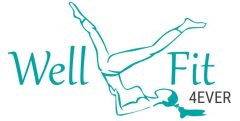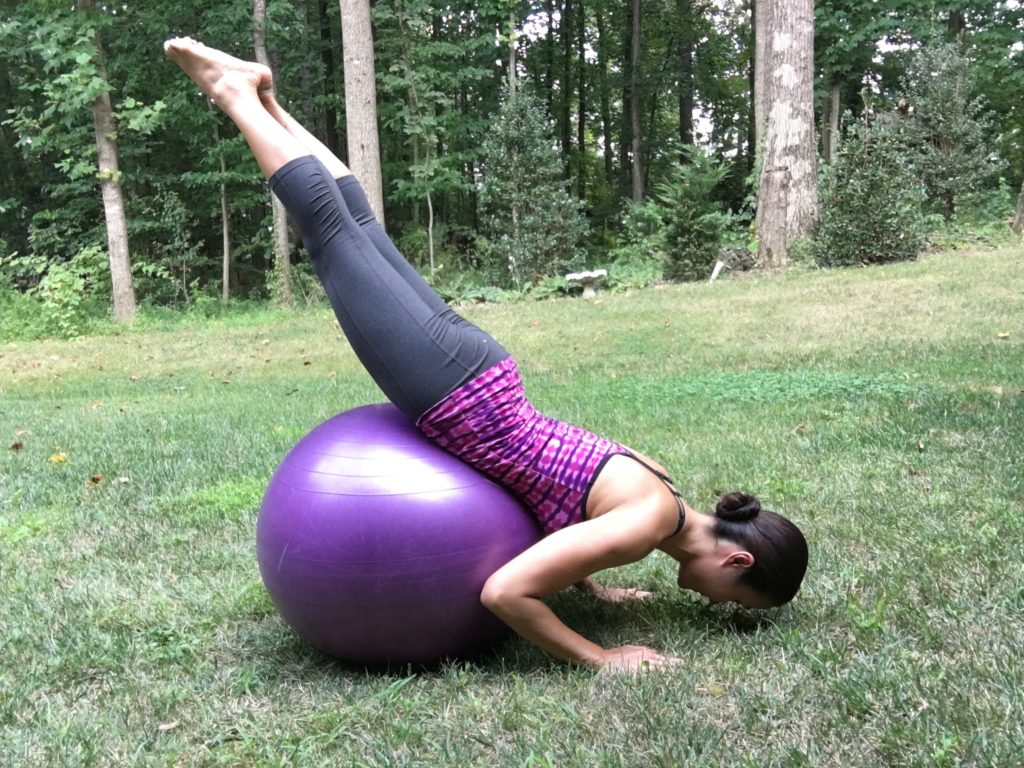Extensor muscles are the postural muscles, the muscles on the backside of the body that keep our body upright. In everyday life we walk forward, bend forward, but how often do we walk backward and bend backward? Maybe never.
When extensors are weak, we have hunched back, forwarded shoulders, flat lower-back, flat butt, aches and pains in the neck, back, hip, and more serious problems, such as slipped discs–a very common thing these days.
We can absolutely prevent these problems by working the extensor muscles. This simple workout routine on the stability ball is aimed to target all the extensor muscles. These exercises are modifiable to suit people with shoulder and/or lower back issues. Incorporate these extensor exercises in your workout routine for better posture and a more balanced body.
All the exercises in this series are in prone position (body facing down) on the stability ball. Make sure you have a ball that is the right size for your body. To learn what size ball is the right one, scroll down to the bottom of this page.
Now let’s get to the exercises!
1. Scapula Protraction and Retraction (as warmup)
Prone (face the floor) on the ball. Hands on floor, directly under shoulders. Fingers point forward and spread wide (for strong support). Legs are together as one leg. Spine is in lengthened position and abdominals are engaged throughout the exercise. Walk hands forward so the ball will roll further down the legs. Find a challenging spot to stay. You should be able to maintain the body in plank shape. Stay….
-Inhale, push the floor as lifting the chest higher–protract the shoulder blades.
-Exhale, arms are still straight (but not locked), glide the shoulder blades toward each other–retract.
Repeat shoulder blade prostrations and retractions 10 times.
Modification for a weak back and/or shoulders: set the ball under the pelvis, you can even have your feet touching the floor. Make sure your spine is in a lengthened position and the abdominals are engaged.
2. One Arm Lift
Prone on the ball. Straight arms support directly under the shoulders. Straight legs are at shoulder-width apart; toes tucked firmly on the floor. Lengthen the spine. Lengthen the shoulders away from the ears. Pull belly in…
-Inhale, prepare.
-Exhale, carefully lift one arm up, maintaining entire body stability.
-Inhale, slowly replace the arm.
-Exhale, with control lift the other arm up.
Continue lifting and lowering one arm at a time.
Right and left make 1 repetition. Do 3-5 repetitions.
Modifications:
-For limited shoulder movement: simply lift hand from floor, pulling elbow back (nick name for the exercise is “Puppy in the Snow”).
-For weak shoulders and/or back: bend knees.
-More stability challenge: lift arm up then take it out to the side before lowering down.
3. Single Leg Extension + Hamstring Curl
Keep the same set up as previous exercise. Be sure to support upper-body muscularly throughout the exercise.
-Inhale, prepare.
-Exhale, lift one straight leg until you feel your gluteus maximus contracting.
-Inhale, lower the leg a few inches.
-Continue to lift and lower the same leg 10 times, then keep the leg lifted.
-Exhale, bend knee (without dropping it), bringing heel toward butt.
-Inhale, stretch that leg completely (still lifted).
Repeat bend and stretch 10 times.
Switch leg, starting with 10 repetitions of lift and lower, then 10 repetitions of bend and stretch.
4. Heel Squeeze
From the previous exercise, walk hands forward a few inches so that the ball is now supporting under the pelvis and your legs are in the air. Maintain spine in a neutral position. Bend knees and bring heels together. Knees are slightly wider than hips. Keep supporting the upper-body muscularly by lifting chest from the floor and engaging abdominals.
-Inhale, prepare.
-Exhale, gently squeeze heels together as lifting them directly toward sky.
-Inhale, release just a little.
-Exhale, squeeze and lift.
Continue for a 10 count.
5. Leg Circle
From previous exercise (heel squeeze), still supporting upper-body muscularly, straighten both legs and keep the legs straight throughout the exercise.
-Inhale, prepare.
-Exhale, lift both legs (until your gluteus maximus is contracting), bring them together,
-Inhale, release the legs down slightly and circle them outward.
-Exhale, lift them back up and circle them in until they become one.
Continue to make a total of 5-10 circles.
Repeat in reversed direction for 5-10 circles.
Modification for a weak back: omit the circle motion, keep legs straight, simply open and close legs (beating inner thighs together).
Before moving on to the next exercise, sit back toward your heels to release the lower back for a few breaths.
6. Middle-Upper Back Extension
From the previous exercise (Watch Dog), keep both feet on floor with toes tucked firmly and legs completely straight. Place hands on the ball next to rib cage. Hug elbows in toward the sides of your body. Pull your belly in deeply to protect your lower-back.
-Inhale, flex neck and upper spine forward over the ball.
-Exhale, extend spine starting from top of head to middle of back, slight shoulders down toward back and keep pulling abdominals in.
-Inhale, release spine, draping over the ball.
Do 10 repetitions.
Before moving on the the next exercise, you may want to release the spine by shifting your weight back toward your feet as reach arm forward on the ball.
Modifications:
-For a weak lower back: have knees down on the mat but keep spine is neutral position.
-Intermediate: have arms extend alongside the body with palms facing back, place back of hands on the back of the hips. As you extend the spine, lift the straight arms up and away from the hips. As you release the spine, release the arms down.
-Advanced: place hands in front of forehead with elbows out to the sides, lengthen shoulders away from your ears. As you extend the spine, bring the arms along, keep hands glued under the forehead.
6. Watch Dog
Prone on the ball. Straight arms support directly under shoulders. Straight legs are shoulder-width apart; toes tucked firmly on the floor. Lengthen the spine. Lengthen the shoulders away from the ears. Pull belly in.
-Inhale, prepare.
-Exhale, with control lift one arm and opposite leg, reaching them toward opposite directions. At the same time, pushing the floor and lifting the chest using the supporting arm. Keep supporting leg completely straight and reaching back through the heel. Work on your balance!
-Inhale, release the arm and leg down.
-Exhale, with control lift the other arm and leg.
Right side and left side make 1 repetition. Do 3 or more repetitions. Make one extra repetition on the unstable side.
8. Pushup
From the previous exercise, walk hands forward a few inches so that the ball is now supporting under the pelvis and your legs are in the air. Squeeze straight legs together as one leg. Maintain spine in a neutral position and body is one continuous line from head to toes. Hands are directly under the shoulders with fingers spreading wide and pointing forward. Abdominals are engaged all the way through the exercise.
-Inhale, with control bend elbows and hug them in toward the body; keeping all extensor muscles on to hold the body in straight line.
-Exhale, push floor to extend the arms. Body is still in a straight line, meaning extensor muscles are still working. If your legs drop down you have lost hip extensor engagement.
Do 5-10 repetitions.
Modifications:
-For a weak lower-back: keep legs separated.
-For weak shoulders and/or arms: reduce the range of movement (bend arms less); also, try with hands wider than shoulders and aim elbows out at approximately 45 degree.
-Emphasize triceps (arm extensors): walk hands further forward so ball will support further down toward thighs. Make sure abdominal stays on strong and legs are actively squeezing together so back won’t arch.
-Emphasize gluteus (hip extensors) and lower back (back extensor): have ball supporting under pelvis. Make sure abdominal, gluteus and inner thighs are very active throughout.
Click here to learn more back exercises.
What size ball should I get? I may write a separate post about how to choose the right ball, but for now here’s the short guide for this particular extensor work routine: the ball should be fairly firm when placed under the pelvis (half under the belly and half under the thighs); you should feel stable with straight arms supporting under shoulders (palms should be flat on the floor) and straight legs with the balls of feet tucked firmly on the floor. Your back should be as parallel with the floor as possible. If you have to be on tiptoes and/or fingertips, the ball is too big. If you have to bend your elbows or squeeze your shoulders together, the ball is too small or too soft.


Love this video Thuy. Well done and thanks . The volume is a little low at times to hear but mainly when you turn your face to the ground when speaking
I will defo do this tomorrow morning as find the ball great especially with the rods in my back..
Thanks for your feedback, especially on the volume. Will try to improve on the next one. Let me know how it works out for you!